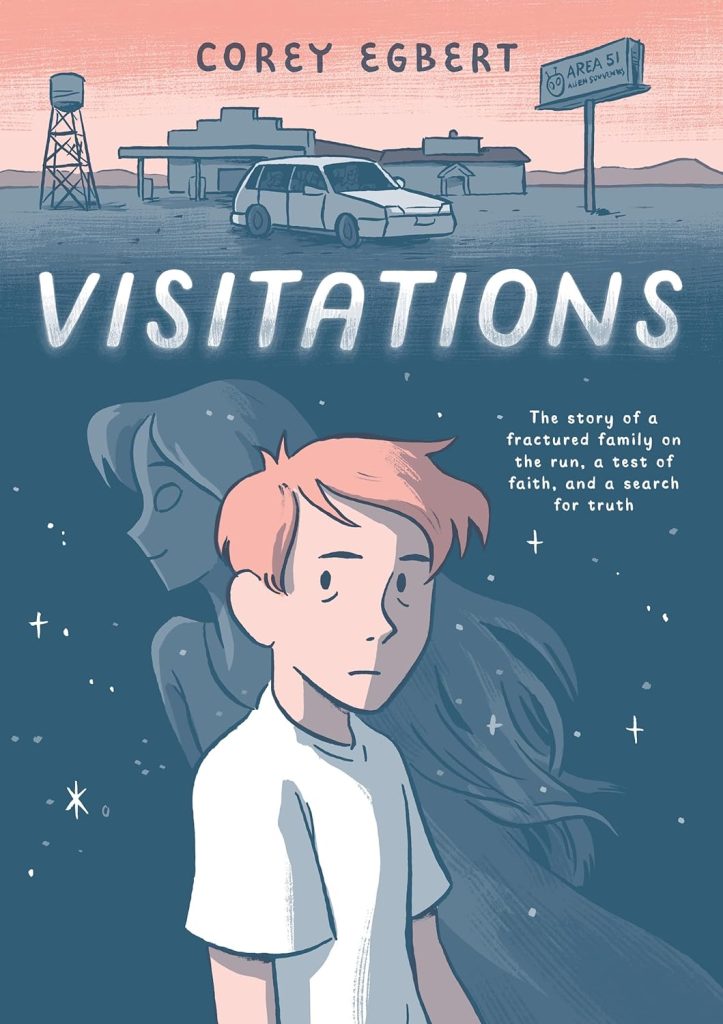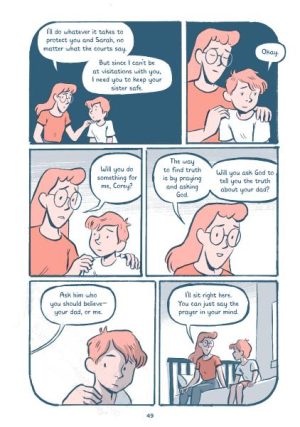Review by Karl Verhoven
The cover to Visitations features a generalised blurb not keen to give much away, and neither does Corey Egbert’s illustration, but it’s an unsettling autobiographical recollection of a family on the run. It’s not too far in before some disturbing territory is reached, beginning with the arrest of the then young Corey’s grandfather for sexual crimes with minors. Beyond that, the teenage Corey enjoys time spent alone in dark woods.
It’s a very appropriate visual metaphor as what the adult Egbert conveys is the uncertainty of childhood. Due to her father’s proclivities Corey’s mother is instantly alert when his younger sister says she doesn’t like her and Corey’s father tickling her. Is this an innocent statement or an indication of something inappropriate or worse? It’s already a troubled marriage, and Corey shows his father’s bonding being reluctant. The courts agree to a divorce, but with no proof of abuse visits to the children are allowed. Their ultra-religious mother rails against this, claiming to know in her heart what their father is like, and constantly attempts to poison the children against him.
Sadly, children of separated parents frequently have to endure unjustified criticism of the party they don’t live with, piling mental pressure on them, and it’s a long way into Visitations before any kind of truth is resolved. The actions of Corey’s mother are guided by prayer and seem extreme, but is she right about his father? After one of those celestial consultations Mrs Egbert determines visitation shouldn’t go ahead, and begins the process of driving her children around the USA, sleeping in the car. “Faith is about trusting in things we can’t see”, is something she explains early, and it’s the mantra by which she lives.
Egbert shows himself drawing from a young age, and for Visitations has evolved a neat form of cartooning that keeps people and backgrounds simple with a limited selection of muted colour, yet it supplies everything necessary. Feelings are shown, most prominently the puzzlement of the young Corey, and there’s a thoughtful use of scenery, both confined spaces and those wide open.
By halfway through Visitations readers will realise Mrs Egbert may be protective, but she’s also deluded. It’s heartbreaking watching the young Corey becoming increasingly conflicted by the faith he’s been brought up to believe and the evidence of his mother’s paranoia. There is no such conflict for his younger sister who might not have the intellectual sophistication, but recognises a wonky chair when she sees it. Corey, however, knows there’s no arguing with anyone claiming god speaks to them.
There’s a brave choice made to bring matters to a close as Corey experiences a long dark night of the soul, learning truths about himself and there being shades of grey between black and white. It’s surprising, touching and ambitious while also a clever method of tying together the story’s themes via mystical realism.
Simply due to the themes explored, Visitations isn’t going to be suitable for everyone, but it has the honesty of personal experience and is an upsetting story extremely well told.





